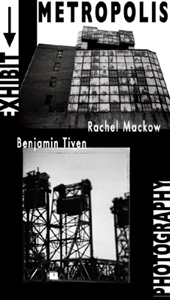KELLY WRITERS HOUSE
ARTIST STATEMENTS
In 1995, a friend and I spent a week in and around Miami. There
was something about that city: lots empty except for a façade propped
up by two by fours, shopping carts burning in parking lots and immense,
abandoned hotels shedding their paint. There was something wild and alive
that existed independently of the people who lived there.
Since then, I have photographed the landscape—full of empty
parking lots, roadways, garages, storefronts, buildings . . . the marks
and tracks of people.
Recently, I travelled to Detroit. Like many cities in the US,
Detroit is an artifact, a ruin, a modern Acropolis. Deco skyscrapers reach
for twentieth century Gods. Each is empty but the upper floors move with
cast light. Street level is hours darker than the rest of the world.
Reflections in the windows multiply the few nomads passing by.
Walking for hours, my companion and I met no one in downtown
Detroit. Crossing paths with one man, we asked where everyone was. He
laughed, spread his arms and said, "WELCOME TO DETROIT."
Metropolis is a depiction of urban ruin. These photographs are
primarily of Philadelphia's industrial sector which I passed through as
an artist and employee of an ironing board factory.
© Rachel Mackow
Benjamin Tiven
These photographs are about the navigation of certain public
spaces and the structures which define them within the landscape. The
encounter with space itself is at the root of these photographs; they are
examinations of depth and distance, and of the clarity and obscurity that
come with those distances. They are all made at places where land
dissolves itself into water—either cities into rivers or oceans
into
continents. I want each photograph to reduce all this vastness and silence
into one visually analytical moment—one where the light, structure,
and
composition within the photograph can convey, or at least imply, the real
sense of space.
To do that, one has to imagine for each picture a visual structure
that will work. Sometimes this is spontaneous, other times an image has
been imagined and the decision of what or where to photograph is in the
interest of instantiating that vision. In both cases, the photograph is
the product of mapping the imagination onto the real. The space in the
mind and the space of the world reflect and inform each other; these
photographs try to explore that relationship.
© Benjamin Tiven
Rachel Mackow
